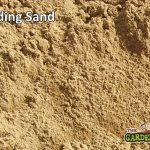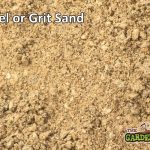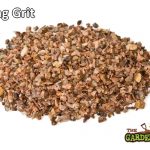Who would have thought that these little grains of silica could cause such confusions & head scratching among us builders and landscapers? Sand in all its forms has so many uses, but if you get the grade or name of sand wrong, the results can be pretty damaging to your project & reputation.There are over 20 different names for sand & bedding sand itself has over 10 different names.
Here at the garden shop we want to clear up any confusion surrounding the different sand types & also try to list every conceivable name that each type has been given throughout Ireland.
Sand as mentioned above is comprised of silica (Quartz) but other minerals can also be found in it including clay particles & iron and it is this that gives sand its colour. The grade of sand is determined by the size of its particles with coarse sands having large particles & fine sands having small particles.
- Building sand
- Grit_Sand
- potting-grit
1. Gravel
Also known as Grit sand, Sharp Sand, Paving Sand and Ballast
- Used to make concrete
- Used as a base for paving
2. Building Sand
Also known as Screeding Sand, Fine Sand, Soft Sand or Bedding Sand, Plastering Sand, Mason or Bricklayer’s Sand
Uses:
- Screed bedding for laying calibrated natural paving flags or block paving
- Used for making mortar when pointing up paving flags
- Bedding sand can be used to make plaster
- Used to make render
- Used to make mortar for laying bricks
3. Silver Sand
Also known as, Jointing Sand, Masonry, White Sand or Washed Sand
- Used to make white renders
- Brush into block paving to lock paving together
4. Potting Grit
Coarse grit which is lime free with particle sizes ranging from 2 – 4mm, 4 – 6mm & 6 – 10mm
- Used to make ideal growing mediums
- Add one handful per litre of compost
- Used as a mulch in pots & containers
- Add a 2-3cm layer over soil surface
- Used to grow alpines
- Ideal growing conditions for alpines & rock plants
- Used on potting benches & in hydroponics
- Can be used in conjunction with heating cables
5. Horticultural Sand
Coarse sand which is lime free
This can be used to improve soil drainage. Other uses:
- Use in compost mixes
- Horticultural sand is mostly mixed with composts to improve drainage & aeration
- Add 20-30 grams per 1 litre of compost
- Sowing Seeds & Cuttings
- Ideal for starting seeds & caring for cuttings
- Reduces the risk of damping off & other fungal diseases
- Mix 1 part sand to 3 parts compost
- Lawn Dressing
- Use after scarifying & aerating your lawn
- Scatter the sand over the lawn surface & brush in with a soft brush
- Capillary Benches
- Ideal for growing benches
- Spread 4 – 6cm layer over the surface of the bench
- Can be used in conjunction with heated cables
- Creates the ideal drainage conditions for pots
- Breaking Up Heavy Soils
- Large amounts of sand would be required for this task
- Apply 1 shovel per 1m2


